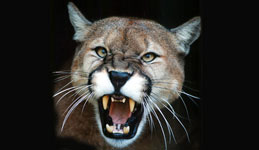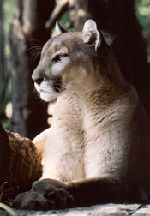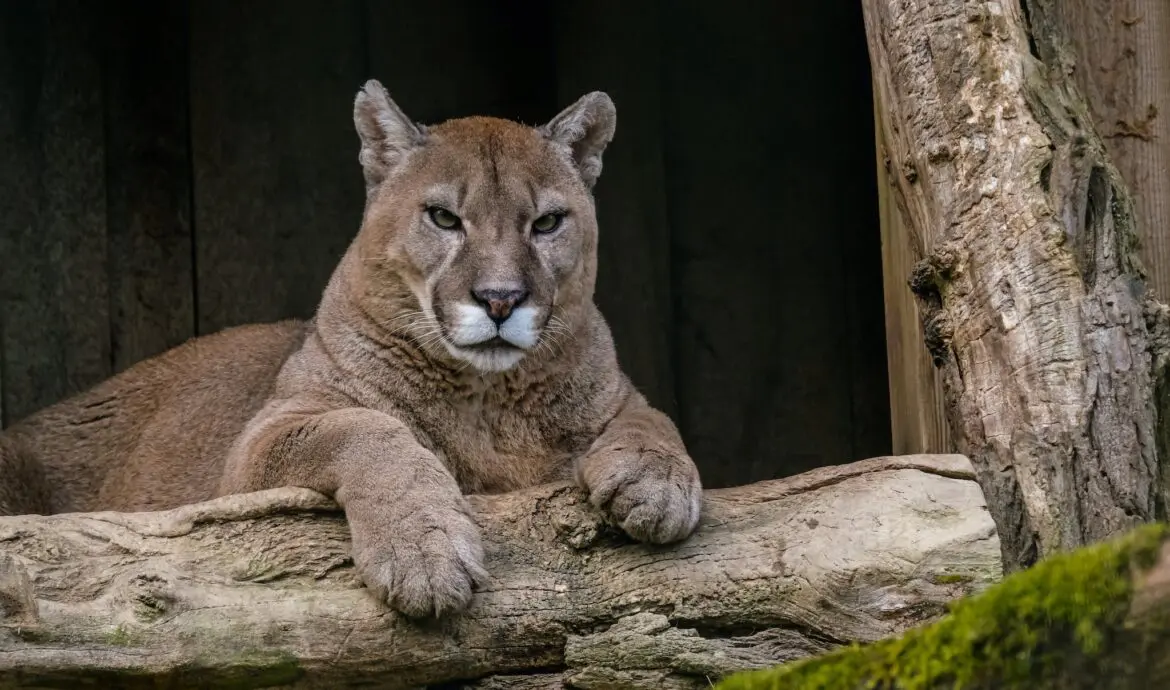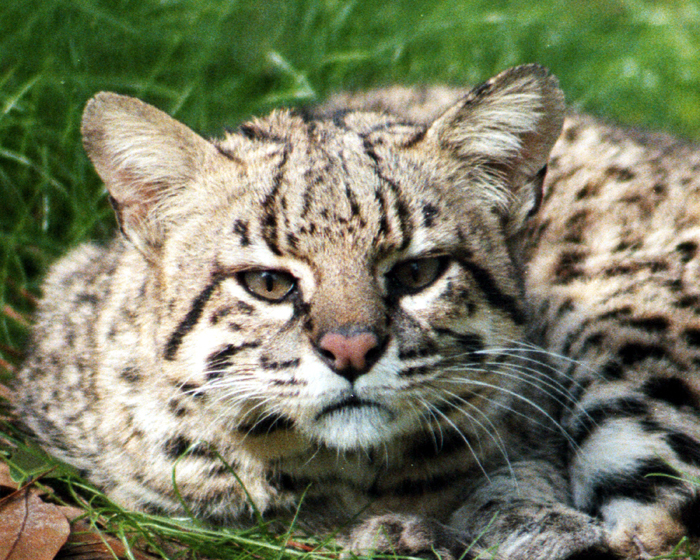Cougar Facts
Cougar – Felis concolor
Common Names: Cougar, Puma, Panther,
Mountain Lion, Catamount
 Kingdom: Animalia
Kingdom: Animalia
Phylum: Chordata (Vertebrata)
Class: Mammalia
Order: Carnivora
Family: Felidae
Genus: Felinae (Puma)
Species: concolor
Sub-species:
Eastern Texas to Florida – P.c.coryi –IUCN: Endangered, CITES:Appendix I Northeastern US and southeastern Canada Cougar – P.c. couguar – IUCN: Endangered, CITES: Appendix I Central American Cougar – P.c. costaricensis – CITES: Appendix I
Misc: The cougar has the greatest natural distribution of any mammal in the Western Hemisphere except for man.
The cougar is extremely agile and has great jumping power and may leap from the ground up to a height of 18 feet into a tree. It is a good swimmer but prefers not to enter the water. Sight is its most acute sense with a good sense of hearing, but is thought to have a poorly developed sense of smell.
Size and Appearance: The cougar is the largest cat in the genus “felis”, and is comparable in size as the leopard. They vary in length from 59 – 108 inches with a tail length of 21 – 36 inches, and height from 23 – 28 inches at the shoulder. Weight can vary greatly, between 75 and 250 pounds. They have a long body with a small head, short face, and a long neck and tail. They are powerfully built, and the hind legs are larger than the front. The ears are small, short and rounded.
 Habitat: The cougar thrives in montane, coniferous forests, lowland tropical forests, swamps, grassland, dry brush country, or any other area with adequate cover and prey.
Habitat: The cougar thrives in montane, coniferous forests, lowland tropical forests, swamps, grassland, dry brush country, or any other area with adequate cover and prey.
Distribution: Western North America from British Columbia and south Alberta south through west Wyoming to California and west Texas. Also south Texas, Louisiana, south Alabama, Tennessee, and peninsular Florida.
Reproduction and Offspring: There is no fixed mating season, but in North America, the majority of births occur between late winter and early spring. Females tend to reproduce every other year, and give birth to litters of 1 – 6 (usually 2-3) cougar kittens after a gestation of 90-96 days. Mothers give birth to their young in dens that are lined with moss or vegetation, usually in rock shelters, crevices, piles of rocks, thickets, caves, or some other protected place. Kittens weigh approximately 7-16 ounces at birth, and have spotted coats until they are around 6 months old. They will continue to nurse for 3 or more months, but will begin to take meat at 6 weeks. The kittens will remain with their mothers until they are 1-2 years old, and after separating, siblings will remain together for another 2-3 months. Females reach sexual maturity around 2.5 and males around 3 years. They will not begin to reproduce until they have established themselves a permanent home area. The may remain reproductive until 12 years of age for females, and 20 years for males.
In captivity, cougars have lived over 20 years, as compared to 8 – 10 in the wild. At Big Cat Rescue one cougar lived to one month shy of 30 years.
Social System and Communication: Cougars are solitary cats and will avoid other individuals except for during mating. They communicate by the use visual and olfactory signals, and the males regularly make scrapes in the soil or snow. Their vocalizations include growls, hisses, and bird-like whistles. They purr like the domestic cats, and during estrus, the females give off loud, hair-raising screams. Hear our purrs, hisses, snarls, calls, and growl sounds HERE
Hunting and Diet: Cougars primarily feed on large mammals, preferring deer, but they will also eat Coyotes, Porcupines, Beaver, mice marmots, hares, raccoons, birds and even grasshoppers. They kill by stalking to within 30 feet of their prey before pouncing from its hiding place. It leaps onto its victim’s back and bites into the neck and holds with its sharp claws.
 Principal Threats: According to 2001 statistics provided from actual sales of hunting permits, almost 2100 cougars are still being killed each year. This figure does not include all the cougars killed by hunters who do not buy licenses nor report their kills. Less than 3% of our population are hunters but they kill over 100 million animals each year for sport.
Principal Threats: According to 2001 statistics provided from actual sales of hunting permits, almost 2100 cougars are still being killed each year. This figure does not include all the cougars killed by hunters who do not buy licenses nor report their kills. Less than 3% of our population are hunters but they kill over 100 million animals each year for sport.
Status: CITES: Appendix I, USDI: Endangered
2003 Felid TAG recommendation: Puma (Puma concolor). A widely held species, the Felid TAG is urging the elimination of this species from collections, whenever possible, in favor of similar-sized, but rarer SSP or PMP felid species. Only acquisition of pumas needed for education or zoogeographic exhibit themes is recommended. With the exception of the Florida panther, no breeding is recommended. The present zoo population of pumas is comprised of more than 200 individuals, and the studbook keeper is striving to reduce this number to 120 or less. In cases of exhibition need, new animals should be acquired from other AZA institutions or, alternatively, couger cubs from sanctuary or rescue programs.
How rare are cougers? The International Species Information Service lists 334 in zoos worldwide, with 119 being in the U.S.
See Conservation Work Funded By Big Cat Rescue here:
All conservation insitu work: https://bigcatrescue.org/insitu/








I love cats. I think that they are the cutest animal in the world. They are so adorable.
not when they are 22 feet from you and exceed speeds of 35 mph and leap 18 feet in height at single bound their claws and huge teeth are over 3 inches long! they can rip through human flesh like hot knife through warm butter!
We just had our amazing encounter yesterday, to worried about our little animals to grab camera in time!
I banged on building and yelled growled and didn’t phaze the little one while still in beautiful, brilliant spots it had a grin from ear to ear as it jumped on top of our near 6′ fence w/o effort and looked at me as i fumbled for phone and picture didn’t come out through slider screen! momma apparently kept walking little one on fence jumped on top of neighbors kids playhouse about 7′ ,,,,,, very beautiful in deed just happened to fast to be that close to the critter,,, im grateful to The Lord our animals are good and I didn’t have to kill a wildcat ! I’m quite bummed we didn’t get video or pics of them …. i initially yelled Bobcat,,, was just too fast to get silly puppy under control , but upon realizing size of momma well over 2 feet at shoulders was no bobcat. i would of normally noticed tail, ears and such,,,. but was all in matter of a few seconds! keep a building between you and these precious pretty creatures, they think you are beautiful too……for their next meal imagining fresh raw blood flesh
I LOVE Cougars! I think it should be illegal to hunt them and illegal for private individuals to own them. Places like Big Cat Rescue are a godsend for all Big and Lesser Cats.
The Florida Panther holds a special place in my heart. Thank you Big Cat Rescue for all you do for all the big cats.
Beautiful wilcats my mom was from Kentucky an she said they scream like women.
haha
Your map needs to be corrected on where they are. I have seen them in Missouri. Many hit by cars on the Highway.
Send pics so we can prove it if we make the statement.
I have heard of them being seen around here, too. Being elusive, their pictures are typically only on hunting cameras.
I love cougars God created the most beautiful wild cat.
We have them in Pennsylvania, also.
I live in Idaho and there was a juvenile cub running around the subdivisions. Unfortunately, many people were excited at the chance to shoot it. Also, last summer there was one around the Greenbelt by the Boise River.
Lo and behold, as soon as I get off this website, I find a new article about cougars in Caldwell https://www.kboi2.com/news/local/Mountain-lion-caldwell-sightings-228721291.html
Crazy
I've seen 5 in the wild in Utah where I live. I saw them for a long time
Carole, I know this is a year later than your request for proof, but here's a link to the Missouri Department of Conservation's map of confirmed cougar sightings in Missouri. It also lists information on DNA tests on hair that indicate the origin of many of the animals' family lines. https://mdc.mo.gov/discover-nature/wildlife-reporting/mountain-lion-reports/confirmed-mountain-lion-reports
Got pics on my trail cam in Maine.
See John Holyoke's Blog at Bangor Daily News.
Interesting.. but they say there hasn’t been a siting in NB since 1938..🤦♂️
I swear I saw one in Maryland a few weeks ago. NOBODY believes me but I know what I saw then today while hiking in the same woods I photographed a very large cat track .. hmmmm
We have them in Arkansas, too! Here’s a link to a news channel on the subject. There was also a woman killed by a mountain lion in the Chimes area, where Searcy county and Van Buren County cut back and forth. You need to update your map. They’re in a lot more states than you think! Besides being in AR. they’re in CO, OK, MO, etc. https://katv.com/archive/game-and-fish-says-mountain-lions-are-in-arkansas-but-arent-breeding
We have them in Wisconsin and Minnesota. I don’t think it is a big population, but they have been seen and photographed. One was recently seen in the twin cities and it got killed on the highway.
They are totally in MO. My husband has had 4 first hand sighting (I with him for 2 of them) in 3 years and this is just at our weekend place. To say they aren’t breeding here, that males are just passing through is ridiculous. Missouri has over 7000 caves, perfect places to raise kittens. The first 2 my husband saw (could have been the same, small so juvenile or female but the 3 and 4 time it was the same big male with a month of time passing in between. I share a fence line with Mark Twain forest .
There are also black panthers in AR. We’ve had sightings in the Chimes area going back more than 2 decades.
Black Panther is just a different name for a melanistic Cougar (i.e a cougar with a genetic variation that makes its coat black). So its entirely possible, and not super surprising that they are there. There are definitely cougars in Arizona, and there’s no reason why there couldn’t be malanistic cougars there, although the melanistic ones are more common in Central and South America I think.
I have always loved the beautiful markings on cougars and their solitary nature. It was interesting to learn that they tend to avoid other cougars unless they are hunting or mating. Your information that their primary threat is from hunters makes me wonder if there should be more regulation on cougar hunts.
You say there are 119 in the U.S. Thats absurd. The Washington State Department of Fish and Wildlife estimates 1,500 in the State of Washington alone. I don’t know where you got your numbers but they are absolutely wrong.
Umm…did you miss the “in zoos” part of that statement?
Cougars are the best (2022)
THE best :>
Can someone tell me if one lives like my area how far will they travel from their den